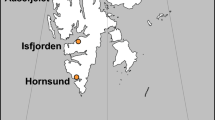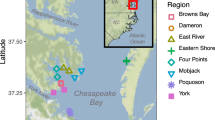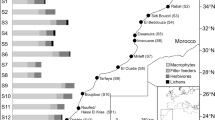Abstract
The distribution patterns of sessile organisms in coastal intertidal habitats typically exhibit vertical zonation, but little is known about variability in zonation among sites or species at larger spatial scales. Data on such heterogeneity could inform mechanistic understanding of factors affecting species distributions as well as efforts to assess and manage coastal species and habitat vulnerability to sea-level rise. Using data on the vertical distribution of common plant species at 12 tidal marshes across the US Pacific coast, we examined heterogeneity in patterns of zonation to test whether distributions varied by site, species, or latitude. Interspecific zonation was evident at most sites, but the vertical niches of co-occurring common species often overlapped considerably. The median elevation of most species varied across marshes, with site-specific differences in marsh elevation profiles more important than differences in latitude that reflect regional climate gradients. Some common species consistently inhabited lower or higher elevations relative to other species, but others varied among sites. Vertical niche breadth varied more than twofold among species. These results indicate that zonation varies by both site and species at the regional scale, and highlight the potential importance of local marsh elevation profiles to plant vertical distributions. Furthermore, they suggest that coastal foundation species such as marsh plants may differ in their vulnerability to sea-level rise by being restricted to specific elevation zones or by occurring in narrow vertical niches.








Similar content being viewed by others
References
Baldwin, B.G., D.H. Goldman, D.J. Keil, R. Patterson, T.J. Rosatti, and D.H. Wilken, eds. 2012. The Jepson Manual. Vascular Plants of California. 2nd ed. Berkeley, CA: University of California Press.
Bertness, M.D. 1991a. Interspecific interactions among high marsh perennials in a New England salt marsh. Ecology 72 (1): 125–137.
Bertness, M.D. 1991b. Zonation of Spartina patens and Spartina alterniflora in a New England salt marsh. Ecology 72 (1): 138–148.
Bertness, M.D., and A.M. Ellison. 1987. Determinants of pattern in a New England salt marsh plant community. Ecological Monographs 57 (2): 129–147.
Bertness, M.D., and S.D. Hacker. 1994. Physical stress and positive associations among marsh plants. The American Naturalist 144 (3): 363–372.
Bockelmann, A.-C., and R. Neuhaus. 1999. Competitive exclusion of Elymus athericus from a high-stress habitat in a European salt marsh. Journal of Ecology 87 (3): 503–513.
Bonin, C.L., and J.B. Zedler. 2008. Southern California salt marsh dominance relates to plant traits and plasticity. Estuaries and Coasts 31 (4): 682–693.
Castillo, J.M., L. Fernández-Baco, E.M. Castellanos, C.J. Luque, M.E. Figueroa, and A.J. Davy. 2000. Lower limits of Spartina densiflora and S. maritima in a Mediterranean salt marsh determined by different ecophysiological tolerances. Journal of Ecology 88 (5): 801–812.
Chapman, V.J. 1939. Studies in salt-marsh ecology sections IV and V. Journal of Ecology 27 (1): 160–201.
Chapman, V.J. 1940. Studies in salt-marsh ecology sections VI and VII. Comparison with marshes on the east coast of North America. Journal of Ecology 28 (1): 118–152.
Chappuis, E., M. Terradas, M.E. Cefalì, S. Mariani, and E. Ballesteros. 2014. Vertical zonation is the main distribution pattern of littoral assemblages on rocky shores at a regional scale. Estuarine, Coastal and Shelf Science 147: 113–122.
Costa, C.S.B., J.C. Marangoni, and A.M.G. Azevedo. 2003. Plant zonation in irregularly flooded salt marshes: Relative importance of stress tolerance and biological interactions. Journal of Ecology 91 (6): 951–965.
Doty, M.S. 1946. Critical tide factors that are correlated with the vertical distribution of marine algae and other organisms along the Pacific coast. Ecology 27 (4): 315–328.
Eleuterius, L.N., and C.K. Eleuterius. 1979. Tide levels and salt marsh zonation. Bulletin of Marine Science 29: 394–400.
Elmendorf, S.C., and K.A. Moore. 2007. Plant competition varies with community composition in an edaphically complex landscape. Ecology 88 (10): 2640–2650.
Engels, J.G., F. Rink, and K. Jensen. 2011. Stress tolerance and biotic interactions determine plant zonation patterns in estuarine marshes during seedling emergence and early establishment. Journal of Ecology 99 (1): 277–287.
Fariña, J.M., B.R. Silliman, and M.D. Bertness. 2009. Can conservation biologists rely on established community structure rules to manage novel systems? … not in salt marshes. Ecological Applications 19 (2): 413–422.
Feigelson, E., and G.J. Babu. 2017. Beware the Kolmogorov-Smirnov test! Astrostatistics and Astroinformatics Portal, The Pennsylvania State University. https://asaip.psu.edu/Articles/beware-the-kolmogorov-smirnov-test, accessed 25 Oct 2017.
Griffin, P.J., T. Theodose, and M. Dionne. 2011. Landscape patterns of forb panes across a northern New England salt marsh. Wetlands 31 (1): 25–33.
Hinde, H.P. 1954. The vertical distribution of salt marsh phanerograms in relation to tide levels. Ecological Monographs 24 (2): 209–225.
Janousek, C.N., and C.L. Folger. 2014. Variation in tidal wetland plant diversity and composition within and among coastal estuaries: Assessing the relative importance of environmental gradients. Journal of Vegetation Science 25 (2): 534–545.
Janousek, C.N., K.J. Buffington, K.M. Thorne, G.R. Guntenspergen, J.Y. Takekawa, and B.D. Dugger. 2016. Potential effects of sea-level rise on plant productivity: Species-specific responses in Northeast Pacific tidal marshes. Marine Ecology Progress Series 548: 111–125.
Kim, D., D.M. Cairns, J. Bartholdy, and C.L.S. Morgan. 2012. Scale-dependent correspondence of floristic and edaphic gradients across salt marsh creeks. Annals of the Association of American Geographers 102 (2): 276–294.
Kirwan, M.L., J.A. Langley, G.R. Guntenspergen, and J.P. Megonigal. 2013. The impact of sea-level rise on organic matter decay rates in Chesapeake Bay brackish tidal marshes. Biogeosciences 10 (3): 1869–1876.
Levine, J.M., J.S. Brewer, and M.D. Bertness. 1998. Nutrients, competition and plant zonation in a New England salt marsh. Journal of Ecology 86 (2): 285–292.
Mahall, B.E., and R.B. Park. 1976. The ecotone between Spartina foliosa Trin. and Salicornia virginica L. in salt marshes of northern San Francisco Bay III. Soil aeration and tidal immersion. Journal of Ecology 64: 811–819.
McKee, K.L., and W.H. Patrick Jr. 1988. The relationship of smooth cordgrass (Spartina alterniflora) to tidal datums: A review. Estuaries 11: 143–151, 3.
Niering, W.A., and R.S. Warren. 1980. Vegetation patterns and processes in New England salt marshes. BioScience 30 (5): 301–307.
Noto, A.E., and J.B. Shurin. 2017. Early stages of sea-level rise lead to decreased salt marsh plant diversity through stronger competition in Mediterranean-climate marshes. PLoS One 12 (1): e0169056.
Osland, M.J., R.H. Day, C.T. Hall, M.D. Brumfield, J.L. Dugas, and W.R. Jones. 2017. Mangrove expansion and contraction at a poleward range limit: Climate extremes and land-ocean temperature gradients. Ecology 98 (1): 125–137.
Page, H.M., S. Schroeter, D. Reed, R.F. Ambrose, J. Callaway, and J. Dixon. 2003. An inexpensive method to identify the elevation of tidally inundated habitat in coastal wetlands. Bulletin of the Southern California Academy of Sciences 102: 130–142.
Pennings, S.C., and R.M. Callaway. 1992. Salt marsh plant zonation: The relative importance of competition and physical factors. Ecology 73 (2): 681–690.
Pennings, S.C., M.-B. Grant, and M.D. Bertness. 2005. Plant zonation in low-latitude salt marshes: Disentangling the roles of flooding, salinity and competition. Journal of Ecology 93 (1): 159–167.
Piirainen, M., O. Liebisch, and G. Kadereit. 2017. Phylogeny, biogeography, systematics and taxonomy of Salicornioideae (Amaranthaceae/Chenopodiaceae) - A cosmopolitan, highly specialized hygrohalophyte lineage dating back to the Oligocene. Taxon 66:109–132.
Russell, P.J., T.J. Flowers, and M.J. Hutchings. 1985. Comparison of niche breadths and overlaps of halophytes on salt marshes of differing diversity. Vegetatio 61 (1-3): 171–178.
Sánchez, J.M., J. Izco, and M. Medrano. 1996. Relationships between vegetation zonation and altitude in a salt-marsh system in Northwest Spain. Journal of Vegetation Science 7 (5): 695–702.
Schile, L.M., J.C. Callaway, V.T. Parker, and M.C. Vasey. 2011. Salinity and inundation influence productivity of the halophytic plant Sarcocornia pacifica. Wetlands 31 (6): 1165–1174.
Schile, L.M., J.C. Callaway, K.N. Suding, and N.M. Kelly. 2017. Can community structure track sea-level rise? Stress and competitive controls in tidal wetlands. Ecology and Evolution 7 (4): 1276–1285.
Sekhon, J. 2011. Multivariate and propensity score matching software with automated balance optimization: The Matching package for R. Journal of Statistical Software 42: 1–52.
Silvestri, S., A. Defina, and M. Marani. 2005. Tidal regime, salinity and salt marsh plant zonation. Estuarine, Coastal and Shelf Science 62 (1-2): 119–130.
Snedden, G.A., K. Cretini, and B. Patton. 2015. Inundation and salinity impacts to above- and belowground productivity in Spartina patens and Spartina alterniflora in the Mississippi River deltaic plain: Implications for using river diversions as restoration tools. Ecological Engineering 81: 133–139.
Sokal, R.R., and F.J. Rohlf. 1995. Biometry. 3rd ed. New York: W.H. Freeman and Company.
Swanson, K.M., J.Z. Drexler, D.H. Schoellhamer, K.M. Thorne, M.L. Casazza, C.T. Overton, J.C. Callaway, and J.Y. Takekawa. 2014. Wetland accretion rate model of ecosystem resilience (WARMER) and its application to habitat sustainability for endangered species in the San Francisco estuary. Estuaries and Coasts 37 (2): 476–492.
Thorne, K.M. 2015. Sea-level rise projections for and observational data of tidal marshes along the California coast. USGS ScienceBase Data Repository. https://doi.org/10.5066/F7RX99V3.
Thorne, K.M., K.J. Buffington, C.M. Freeman, K.W. Powelson, G.M. Block, and J.Y. Takekawa. 2014. Projecting tidal marsh response to sea-level rise using local site conditions: San Diego Bay National Wildlife Refuge: Sweetwater Unit. Unpublished data summary report. Vallejo, CA: U.S. Geological Survey, Western Ecological Research Center, 41 pp.
Thorne, K.M., B. Dugger, J.Y. Takekawa, G.R. Guntenspergen, C. Janousek, K. Buffington, C.M. Freeman, and K. Powelson. 2015a. Marshes to mudflats: Climate change effects along coastal estuaries in the Pacific northwest. USGS ScienceBase Data Repository. https://doi.org/10.5066/F7SJ1HNC.
Thorne, K.M., B.D. Dugger, K.J. Buffington, C.M. Freeman, C.N. Janousek, K.W. Powelson, G.R. Guntenspergen, and J.Y. Takekawa. 2015b. Marshes to mudflats – effects of sea-level rise on tidal marshes along a latitudinal gradient in the Pacific Northwest. U.S. Geological Survey Open-File Report 2015–1204, 54 p. + appendices.
Thorne, K.M., G.M. MacDonald, R.F. Ambrose, K.J. Buffington, C.M. Freeman, C.N. Janousek, L.N. Brown, J.R. Holmquist, G.R. Guntenspergen, K.W. Powelson, P.L. Barnard, J.Y. Takekawa. 2016. Effects of climate change on tidal marshes along a latitudinal gradient in California. U.S. Geological Survey Open-File Report 2016–1125, 75 p. + appendices.
Thorne, K., G. MacDonald, G. Guntenspergen, R. Ambrose, K. Buffington, B. Dugger, C. Freeman, C. Janousek, L. Brown, J. Rosencranz, J. Holmquist, J. Smol, K. Hargan, and J. Takekawa. 2018. U.S. Pacific coastal wetland resilience and vulnerability to sea-level rise. Science Advances 4 (2): eaao3270.
Van de Koppel, J., A.H. Altieri, B.R. Silliman, J.F. Bruno, and M.D. Bertness. 2006. Scale-dependent interactions and community structure on cobble beaches. Ecology Letters 9 (1): 45–50.
Vince, S.W., and A.A. Snow. 1984. Plant zonation in an Alaskan salt marsh. I. Distribution, abundance and environmental factors. Journal of Ecology 72 (2): 651–667.
Watson, E.B., and R. Byrne. 2009. Abundance and diversity of tidal marsh plants along the salinity gradient of the San Francisco estuary: Implications for global change ecology. Plant Ecology 205 (1): 113–128.
White, S.M., and E.A. Madsen. 2016. Tracking tidal inundation in a coastal salt marsh with Helikite airphotos: Influence of hydrology on ecological zonation at crab Haul Creek, South Carolina. Remote Sensing of Environment 184: 605–614.
Zavaleta, E.S., M.R. Shaw, N.R. Chiariello, B.D. Thomas, E.E. Cleland, C.B. Field, and H.A. Mooney. 2003. Grassland responses to three years of elevated temperature, CO2, precipitation, and N deposition. Ecological Monographs 73 (4): 585–604.
Zedler, J.B. 1977. Salt marsh community structure in the Tijuana estuary, California. Estuarine and Coastal Marine Science 5 (1): 39–53.
Zedler, J.B., J.C. Callaway, J.S. Desmond, G. Vivian-Smith, G.D. Williams, G. Sullivan, A.E. Brewster, and B.K. Bradshaw. 1999. Californian salt-marsh vegetation: An improved model of spatial pattern. Ecosystems 2 (1): 19–35.
Acknowledgements
We thank K. Powelson, K. Lovett, K. Buffington, L. Curry, C. Freeman, L. Bellevue, M. Holt, and H. Robinson who conducted the extensive vegetation and elevation sampling in the field. We also thank C. Freeman (USGS) for producing Fig 1. and Supplementary Fig.1 and J. Callaway, J. Crooks, and two anonymous reviewers for their helpful comments on the manuscript. The Northwest and Southwest Climate Adaptation Science Centers of the US Department of the Interior funded this study, with additional support from NOAA grant NA15NOS4780171. We thank the following agencies and individuals for site access: US Fish and Wildlife Service (A. Yuen, SDB; E. Nelson, MAD; D. Ledig, COQ; R. Lowe, SIL; G. Nakai, GRA), NOAA’s National Estuarine Research Reserve System (J. Crooks, TIJ; C. Cornu, COO), California State Parks (A. Kitajima, MOR), Marin County Parks (W. Carmen, BOL), California Department of Fish and Wildlife and Orange County Parks (C. Navarro, NEW), Skokomish Indian Tribe (S. Kirby, SKO), and the Nature Conservancy (J. Boyd, STI). Most raw data generated for this study are available as USGS data releases. Any use of trade, product, or firm names in this publication is for descriptive purposes only and does not imply endorsement by the US government. The US government is authorized to reproduce and distribute reprints of this article for governmental purposes.
Author information
Authors and Affiliations
Corresponding author
Additional information
Communicated by John C. Callaway
Electronic Supplementary Material
ESM 1
(DOCX 2.09 mb)
Rights and permissions
About this article
Cite this article
Janousek, C.N., Thorne, K.M. & Takekawa, J.Y. Vertical Zonation and Niche Breadth of Tidal Marsh Plants Along the Northeast Pacific Coast. Estuaries and Coasts 42, 85–98 (2019). https://doi.org/10.1007/s12237-018-0420-9
Received:
Revised:
Accepted:
Published:
Issue Date:
DOI: https://doi.org/10.1007/s12237-018-0420-9




